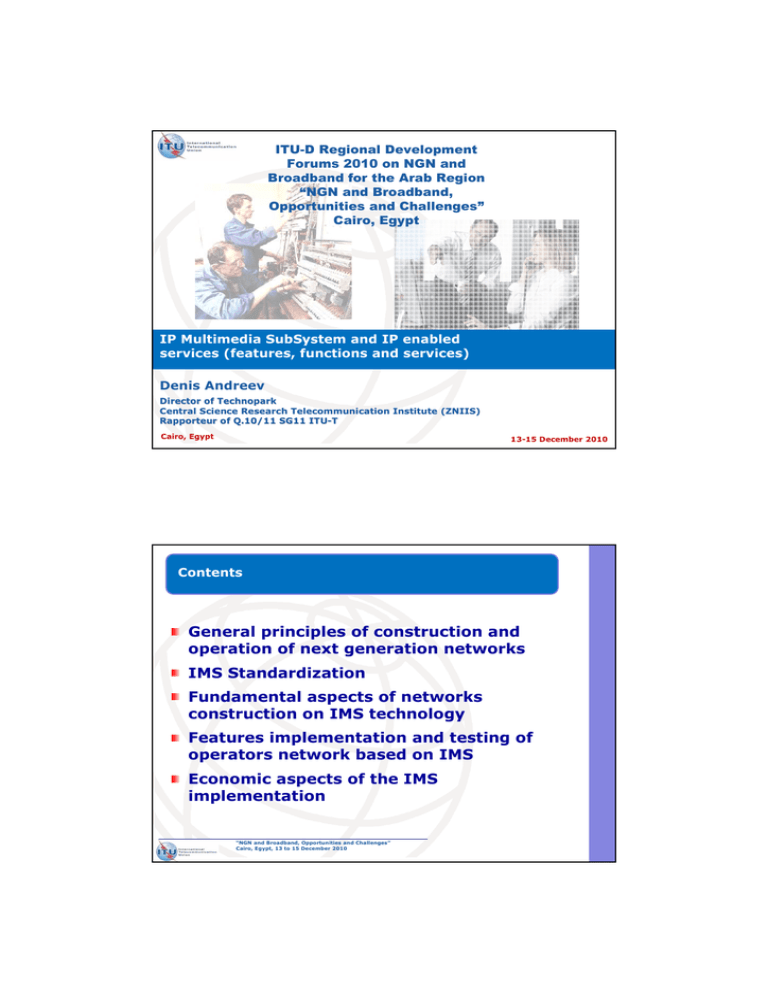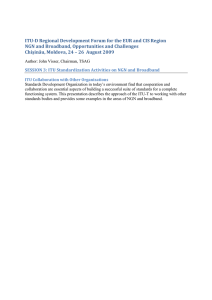ITU-D Regional Development Forums 2010 on NGN and “NGN and Broadband,
advertisement

ITU-D Regional Development Forums 2010 on NGN and Broadband for the Arab Region “NGN and Broadband, Opportunities and Challenges” Cairo, Egypt IP Multimedia SubSystem and IP enabled services (features, functions and services) Denis Andreev Director of Technopark Central Science Research Telecommunication Institute (ZNIIS) Rapporteur of Q.10/11 SG11 ITUITU-T Cairo, Egypt 13-15 December 2010 Contents General principles of construction and operation of next generation networks IMS Standardization Fundamental aspects of networks construction on IMS technology Features implementation and testing of operators network based on IMS Economic aspects of the IMS implementation “NGN and Broadband, Opportunities and Challenges” Cairo, Egypt, 13 to 15 December 2010 General principles of construction and operation of next generation networks NGN (Next Generation Network) - a network with packet switching, suitable for the provision of telecommunication services and the use of multiple broadband transport technologyenabled QoS, in which service-related functions are independent from underlying technologies are responsible for transportation. Rec. ITU-Т Y.2001 “NGN and Broadband, Opportunities and Challenges” Cairo, Egypt, 13 to 15 December 2010 General principles of construction and operation of next generation networks Basic principles of NGN creation The traditional conception of NGN provide possibility creation of a new multi-service network, which carry out the role of instrument for realizing existing and feature services on one platform (equipment) where call control stratum (Softswitch and IMS) is key element of NGN “NGN and Broadband, Opportunities and Challenges” Cairo, Egypt, 13 to 15 December 2010 General principles of construction and operation of next generation networks Functional model of NGN network Applications ANI Management Functions Application Support Functions & Service Support Functions Service User Profiles Service Control Functions Service stratum Network Attachment Control Functions Transport User Profiles End-User Functions Resource and Admission Control Functions Other Networks Transport Control Functions Transport Functions UNI NNI Transport stratum Control Media Management “NGN and Broadband, Opportunities and Challenges” Cairo, Egypt, 13 to 15 December 2010 General principles of construction and operation of next generation networks The typical operator’s NGN architecture “NGN and Broadband, Opportunities and Challenges” Cairo, Egypt, 13 to 15 December 2010 General principles of construction and operation of next generation networks IMS objectives and purpose Objectives: effective integration of voice and multimedia traffic in a single multi-platform standards-based centralization of operational support and control system of major characteristics of the available services Purpose: convergence of networks, application development, deployment of new services and reduce costs through the use of open standards, development of new business models (such as “Virtual Service Provider (VSP)”) “NGN and Broadband, Opportunities and Challenges” Cairo, Egypt, 13 to 15 December 2010 IMS Standardization The actual IMS features for standardization multilevel - split levels of transport, management and applications independence of the media access - enables operators and service providers to converge fixed and mobile networks support multimedia personal information exchange in real time (voice, video telephony) and a similar exchange of information between people and computers (games) full integration of multimedia applications, real and unreal time (streaming applications and chat rooms) interoperability of different services ability to support multiple services in a single session or multiple simultaneous synchronized organizing sessions “NGN and Broadband, Opportunities and Challenges” Cairo, Egypt, 13 to 15 December 2010 IMS Standardization The central standardization organization which develop IMS standards 3GPP 3GPP2 ETSI (European Telecommunication Standards Institute) ITU (International Telecommunication Union) – FG FN OMA (Open Mobile Alliance) TISPAN (Telecoms and Internet converged Services and Protocols for Advanced Networks) ATIS (Alliance for Telecommunication Industry Solutions) “NGN and Broadband, Opportunities and Challenges” Cairo, Egypt, 13 to 15 December 2010 IMS Standardization ITU-T Recommendations, which include requirements to the functionality of IMS solutions and its relationship to the concept of NGN Y.2001 General overview of NGN Y.2011 General principles and general reference model for Next Generation Networks Y.2012 Functional requirements and architecture of next generation networks Y.2021 IMS for Next Generation Networks Y.2211 IMS-based real-time conversational multimedia services over NGN Q.3904 Testing principles for IMS on model networks, and identification of relevant conformance, interoperability and functionality tests “NGN and Broadband, Opportunities and Challenges” Cairo, Egypt, 13 to 15 December 2010 IMS Standardization List of ETSI/3GPP specification series № Series Title of specification series 21 22 23 24 25 26 27 General requirements Services standardization questions (phase 1) Technical realization (phase 2) Signaling protocol (phase 3). Butt of subscriber equipment-network Radio access questions 3G Codec Data transfer 28 29 30 31 32 33 34 35 36 37 Signaling protocol (phase 3). Butt of radio system - network Signaling protocol (phase 3). Butt of fixed network –IP network Project management. Planning Subscriber Identity Module (xSIM). IC cards IMS service and charging questions Security questions Test specifications for subscriber equipment and cards USIM Algorithm for security LTE Radio technology (Evolved UTRA) и LTE-Advanced Questions of Multiple radio access technology “NGN and Broadband, Opportunities and Challenges” Cairo, Egypt, 13 to 15 December 2010 Typical aspects on network development under IMS technology The IMS Functional model The main functional elements of IMS can be divided into the following groups: session control elements - Call Session Control (P,S,ICSCF) database (HSS) elements that provide additional services and respond on resource reservation (application server, MRFC, MRFP) elements provide interworking with another networks (BGCF, MGCF, IMS-MGW, SGW) security elements (PDF) elements billing and statistics “NGN and Broadband, Opportunities and Challenges” Cairo, Egypt, 13 to 15 December 2010 Typical aspects on network development under IMS technology Basic elements P-CSCF (Proxy Call Session Control Function) - first point of contact IMS terminal and the core network, on the signal level, perform the function of IPsec connections S-CSCF (Serving Call Session Control Function) - central element of the IMS solution and performing a function of routing SIP messages and SIP registrar server I-CSCF (Interrogating Call Session Control Function) serves as a contact point for inter-operator interaction HSS (Home Subscribers Server ) - is a database that stores all information relevant to the subscriber (customer) and service profiles “NGN and Broadband, Opportunities and Challenges” Cairo, Egypt, 13 to 15 December 2010 Typical aspects on network development under IMS technology IMS architecture (ETSI ES 282 007 V1.1.1 «IP Multimedia Subsystem (IMS) Functional architecture») “NGN and Broadband, Opportunities and Challenges” Cairo, Egypt, 13 to 15 December 2010 Typical aspects on network development under IMS technology Traditional scheme of operator network based on IMS architecture “NGN and Broadband, Opportunities and Challenges” Cairo, Egypt, 13 to 15 December 2010 Typical aspects on network development under IMS technology Types of platform for services providing Application Server SIP; Application server OSA/Parlay; CAMEL Platform “NGN and Broadband, Opportunities and Challenges” Cairo, Egypt, 13 to 15 December 2010 Typical aspects on network development under IMS technology Actual services widely provided to customer via IMS Presence Instant messaging and Chat Push to Talk File Transfer White board Games Converged TV “NGN and Broadband, Opportunities and Challenges” Cairo, Egypt, 13 to 15 December 2010 IMS implementation and testing on Model and operator networks Approaches to IMS testing Q.3904 ITU-T Recommendation The scenarios, list and types of tests for TM local and NUT testing for IMS on the Model Network “NGN and Broadband, Opportunities and Challenges” Cairo, Egypt, 13 to 15 December 2010 IMS implementation and testing on Model and operator networks IMS Testing methodology ITU-T Recommendation Q.3904 determine integrated approach for testing IMS solutions include following sequence of tests: check for compliance with standards and specifications for the implementation of basic call and provide additional services functional testing testing for interaction (network integration) “NGN and Broadband, Opportunities and Challenges” Cairo, Egypt, 13 to 15 December 2010 IMS implementation and testing on Model and operator networks Typical problems identified during testing of system-network IMS solution Functional checks Registration statistics from different types of equipment which use during session and include to IMS system-network solution Identified problems Lack of detailed call records with mandatory information on the amount of transmitted content (information) for content-oriented services “NGN and Broadband, Opportunities and Challenges” Cairo, Egypt, 13 to 15 December 2010 IMS implementation and testing on Model and operator networks Typical problems identified during testing of system-network IMS solution on interoperability Objective To test the possibility of IMS system-network solution to serve subscriber which is moving to guest network Identified problems The subscriber is connected to ISP’s P-CSC (quest network), maintain at the S-CSC another network, but can not get the basic telecom services in full The reason for this problem The difference in syntax P-Charging-Vector Protocol, SIP IMS, transferred from the P-CSC to the S-CSC, manufacturers support different variants of this parameter which does not determine exactly by the protocol specification “NGN and Broadband, Opportunities and Challenges” Cairo, Egypt, 13 to 15 December 2010 IMS implementation and testing on Model and operator networks Compatibility checking Instance of checking hardware compatibility S-CSC <-> I-CSC Objective To test the possibility of system-network solutions provide correct access to IMS resources after registration SIPterminal using the URI with the corresponding password, and denial of access when is typed an incorrect password Identified problem S-CSC from one vendor supports messaging protocol DIAMETER only using the transport protocol SCTP, and the ICSC another vendor supports messaging protocol DIAMETER only over TCP. As a result of the use of means of communication, using different transport protocols for messaging protocol DIAMETER can not interact “NGN and Broadband, Opportunities and Challenges” Cairo, Egypt, 13 to 15 December 2010 IMS implementation and testing on Model and operator networks Now the decision of the given problems come to application of the corporate standards specifying the international specifications regarding internal functionality demanded to the operator and in case of ISP interworking to the mutual arrangement by a principle of "the minimum expenses” “NGN and Broadband, Opportunities and Challenges” Cairo, Egypt, 13 to 15 December 2010 IMS implementation and testing on Model and operator networks Typical strategy of migration existing networks to IMS technology Scenarios of transition from the existing telephone network based on TDM network to the NGN/IMS network based on PSN Access level Step1 interfaces V.5.x, analog lines (FXS/FXO) and PRI/ BRI interfaces are connect to the PBX separatly “NGN and Broadband, Opportunities and Challenges” Cairo, Egypt, 13 to 15 December 2010 IMS implementation and testing on Model and operator networks Step 2 Connect all user interfaces directly to a subscriber's xDSL equipment. Using high-speed of 1-10 Mbps symmetrical streams (VDSL, SHDSL) Step 3: Migration to a fully digital network access technologies. Using high-speed and symmetric technologies Ethernet, FTTx, PON, etc. “NGN and Broadband, Opportunities and Challenges” Cairo, Egypt, 13 to 15 December 2010 IMS implementation and testing on Model and operator networks Transport level Scenario 1 gradually migration to an IP network by transferring the functionality of transit nodes of TDM network to the appropriate IP network nodes “NGN and Broadband, Opportunities and Challenges” Cairo, Egypt, 13 to 15 December 2010 IMS implementation and testing on Model and operator networks Transport level Scenario 2 Migration to NGN/Softswitch network by connecting Access Points of TDM network to voice and signaling gateway “NGN and Broadband, Opportunities and Challenges” Cairo, Egypt, 13 to 15 December 2010 IMS implementation and testing on Model and operator networks Switch level “NGN and Broadband, Opportunities and Challenges” Cairo, Egypt, 13 to 15 December 2010 IMS implementation and testing on Model and operator networks Typical migration to IMS topology (JSC Svyazinvest, Russia) “NGN and Broadband, Opportunities and Challenges” Cairo, Egypt, 13 to 15 December 2010 IMS implementation and testing on Model and operator networks The set of implementing NGN services based on IMS/SDP VoIP UAN and UPT (possibility to use unique number for different TE: fix line, mobile phone, SIP-phone) Customer Web-portal (customer possibility to personalize and control services through Internet access) IP-Centrex (the set of VAS for corporative customers based on IP networks) “NGN and Broadband, Opportunities and Challenges” Cairo, Egypt, 13 to 15 December 2010 IMS implementation and testing on Model and operator networks Typical business model IMS Profit from providing services, KEuro Capex per year, KEuro OPEX per year, KEuro “NGN and Broadband, Opportunities and Challenges” Cairo, Egypt, 13 to 15 December 2010 Profitability, KEuro IMS implementation and testing on Model and operator networks Current situation on migration to IMS (Infonetics Research) More than 50% ISP are going to provide in future 12-18 month the video phone services and FMC 80% ISP are going to migrate more part of own customer to IMS for providing basic call services Next two years all ISP concentrate own customers to new service packets (RCS – presence, chat, file sharing and etc.) “NGN and Broadband, Opportunities and Challenges” Cairo, Egypt, 13 to 15 December 2010 IMS implementation and testing on Model and operator networks Future telecom forecast on IMS technology (Infonetics Research) Profit of telecommunication service based on SDP are provided on 16 % from operators of a fixed-line telephony, and on 84 % by mobile operators The American ISP based on SDP earned 16 % in 2007 from a world market of services. By the end of 2010 their share has increased to 25 % SDP will lead to a new coil of development of the telecommunication service integrating possibilities of a telephony and the Internet The exist tendency - world leaders (ISP) buying small companies with own product in the SDP field with purpose of creation the advanced decisions under the big brand As an instance of it is recent purchase by manufacturer Motorola of company Leapstone, and BEA Oracle “NGN and Broadband, Opportunities and Challenges” Cairo, Egypt, 13 to 15 December 2010 Economic aspects of the migration to IMS technology Evaluating the effectiveness of projects is usually based on the following indicators: investment (capital costs) operating costs proceeds from the sale pre-tax profit (profit before tax) net profit “NGN and Broadband, Opportunities and Challenges” Cairo, Egypt, 13 to 15 December 2010 Economic aspects of the migration to IMS technology Economic indicators implementing IMS Payroll Number of staff Wages Operators leaders +8,9% -18,5% +35,2% Operators of old Europe (EU15) -14,8% -28,5% +26,1% Operators of the new Europe (EU15) -13,2% -39,7% +50,3% All operators -6,4% -28,9% +37,2% . “NGN and Broadband, Opportunities and Challenges” Cairo, Egypt, 13 to 15 December 2010 Economic aspects of the migration to IMS technology The dynamics of changes in operating costs after upgrading the network Staff kVT H kVT H Staff kVT H kVT H “NGN and Broadband, Opportunities and Challenges” Cairo, Egypt, 13 to 15 December 2010 Staff kVT H kVT H Remote training courses ITU Centre of Excellence for CIS countries Training course «IMS: technical and economic aspects of implementation» September 2010 “NGN and Broadband, Opportunities and Challenges” Cairo, Egypt, 13 to 15 December 2010 Contacts Denis Andreev Director of Technopark ZNIIS, Rapporteur of Q.10/11 SG11 ITU-T tel: +7-495-368-8745 mobile: +7-495-647-9603 fax: +7-495-368-9105 skype: davwilly77 sipnet: 2811971@sipnet.ru E-mail: andreevd@zniis.ru cc: andreevd@ties.itu.int _____________________ Russia, 111141, Moscow, 1-st Proezd perova polya, 8 “NGN and Broadband, Opportunities and Challenges” Cairo, Egypt, 13 to 15 December 2010

